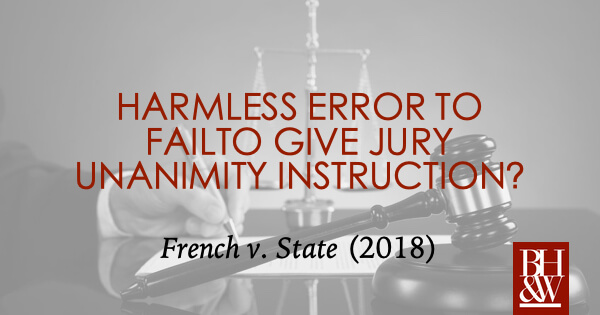
Trial Court Failed to Give Unanimity Instruction to the Jury
The Court of Criminal Appeals recently handed down an opinion regarding a unanimity jury instruction in an aggravated sexual assault case. The issue before the Court was whether the trial court erred when it failed to instruct the jury that it must be unanimous in deciding how the sexual contact occurred when there were multiple allegations. The Court of Criminal Appeals found the jury instruction to be erroneous but concluded no harm occurred.
French v. State, (Court of Criminal Appeals 2018).
The Facts—The Defendant Was Convicted for Aggravated Sexual Assault of a Child
The defendant was originally indicted on a single count of aggravated sexual assault of a child. The indictment alleged that the defendant caused the penetration of the child’s anus by the defendant’s sexual organ. Before trial though, the indictment was amended to add “contact with” and “penetration of” the sexual organ of the child by the defendant’s sexual organ. As a result, the indictment presented four options for a conviction: (1) the defendant contacted the child’s anus with his sexual organ; (2) the defendant penetrated the child’s anus with his sexual organ; (3) the defendant contacted the child’s sexual organ with his sexual organ; and/or (4) the defendant penetrated the child’s sexual organ with his sexual organ.
At trial, the jury instructions authorized the jury to convict the defendant on any one of the four theories. In addition, the trial court explicitly instructed the jury that they need not all agree on the manner in which the sexual assault was committed. This instruction essentially authorized the jury to convict the defendant without agreeing as to which orifice he had “contacted or penetrated”—even though there was little to no evidence presented that defendant ever contacted or penetrated the child’s sexual organ. This prompted the defendant to object and ask the court for a unanimity instruction regarding the manner in which the sexual assault was committed. However, the court overruled the objection and the defendant was subsequently convicted.
The Court of Appeals Reversed the Defendant’s Conviction—Holding the Trial Court Erred in Failing to Submit a Proper Instruction Which Caused “Some Harm”
On appeal, the defendant argued that the jury charge failed to follow the juror unanimity requirement because it did not require the jury to agree as to which orifice he contacted and/or penetrated. For double jeopardy purposes, he argued the theories were considered distinct and separate offenses, each of which demanded juror unanimity for a conviction. The court of appeals agreed, and it held that the trial court erred by failing to submit proper instructions. In light of this error, the court of appeals determined that the erroneous jury charge was sufficient to invoke the “some harm” standard under Almanza, which required a reversal.
The Court of Criminal Appeals Reversed the Court of Appeals’ Judgment—Finding No Actual Harm Occurred
On petition for discretionary review, the State did not contest the erroneous jury charge. Rather, it argued that any error in the jury charge as to the unanimity requirement did not result in harm to the defendant. The Court of Criminal Appeals agreed.
In analyzing whether there was “some harm,” the Court of Criminal Appeals considered the trial court’s error with respect to the four factors set out in Almanza: “(1) the entire jury charge, (2) the state of the evidence, (3) the jury arguments, and (4) any other relevant information as revealed by the record as a whole.”
The Court of Criminal Appeals noted that in concluding that “some harm” occurred the court of appeals only relied upon the second Almanza factor—the state of the evidence. That court identified there was “some evidence in the record” for the jury to potentially conclude that the defendant penetrated both the child’s anus and sexual organ with his own sexual organ. And, since there was “some evidence” it believed that the jury could have regarded itself as authorized to convict different ways without reaching any agreement on a specific theory beyond a reasonable doubt.
However, even considering the above reasoning, the Court of Criminal Appeals determined there was no harm suffered when taking into consideration all four of the Almanza factors. The Court explained that “the risk that a rational juror would have convicted the defendant on the basis that he contacted and/or penetrated the child’s sexual organ with his own—and not also on the basis that he contacted and/or penetrated the child’s anus—is so ‘highly unlikely’ as to be ‘almost infinitesimal.’” Not only was there overwhelming evidence at trial that suggested anal contact and penetration occurred, there was no encouragement for a specific finding, and the defendant’s only defense was that it never happened. All of this supports the Court’s conclusion that the harm was merely hypothetical and not actual. As such, the Court reversed and remanded the case even in light of the error.

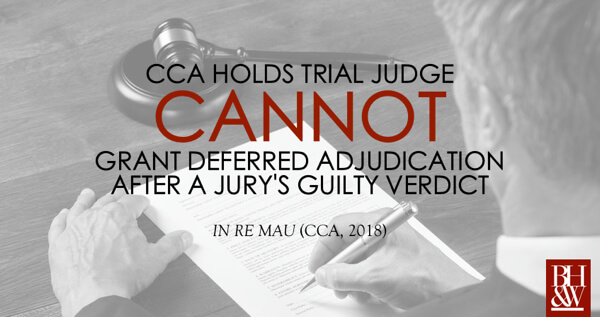
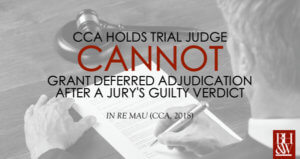 The Court of Criminal Appeals recently handed down an opinion on a petition for writ of mandamus. The two issues facing the court were (1) the nature of a misdemeanor trial after a defendant pleads guilty to a jury; and, (2) whether a trial court has the ability to defer an adjudication of guilt after a jury finds a defendant guilty. The Court of Criminal Appeals declined to grant mandamus relief on the first issue but, for the reasons discussed below, it granted mandamus relief for the second issue.
The Court of Criminal Appeals recently handed down an opinion on a petition for writ of mandamus. The two issues facing the court were (1) the nature of a misdemeanor trial after a defendant pleads guilty to a jury; and, (2) whether a trial court has the ability to defer an adjudication of guilt after a jury finds a defendant guilty. The Court of Criminal Appeals declined to grant mandamus relief on the first issue but, for the reasons discussed below, it granted mandamus relief for the second issue.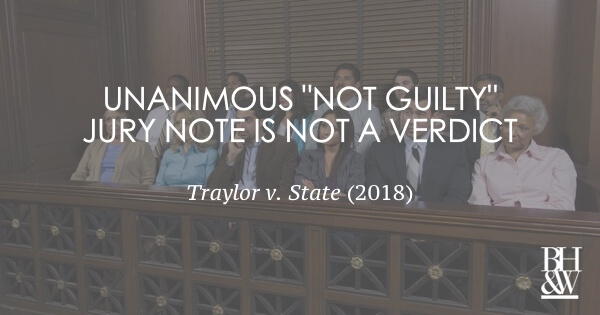
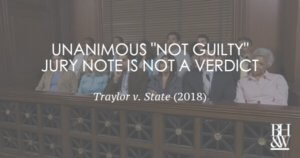 The Court of Criminal Appeals recently handed down an opinion regarding whether a jury can informally acquit based on a unanimous jury note. The issue facing the court was whether a jury note, which provided the jury’s voting breakdown of the charged offense and the lesser included offense, could be considered an acquittal for double jeopardy purposes even though a mistrial was later declared because the jury could not reach a unanimous decision.
The Court of Criminal Appeals recently handed down an opinion regarding whether a jury can informally acquit based on a unanimous jury note. The issue facing the court was whether a jury note, which provided the jury’s voting breakdown of the charged offense and the lesser included offense, could be considered an acquittal for double jeopardy purposes even though a mistrial was later declared because the jury could not reach a unanimous decision.
 In December of 2014, Appellant Luis Miguel Hernandez was convicted of the murder of Devin Toler, an African-American man. During the trial, Appellant claimed self-defense, arguing that Toler attacked him and that by killing him, he was defending himself from the attack. The prosecution, however, presented evidence that Appellant provoked Toler by his words, some of them racial slurs. The actual words of the alleged racial slurs were never presented to the jury in the testimony of any witness or otherwise. However, during closing argument, the prosecutor said the following:
In December of 2014, Appellant Luis Miguel Hernandez was convicted of the murder of Devin Toler, an African-American man. During the trial, Appellant claimed self-defense, arguing that Toler attacked him and that by killing him, he was defending himself from the attack. The prosecution, however, presented evidence that Appellant provoked Toler by his words, some of them racial slurs. The actual words of the alleged racial slurs were never presented to the jury in the testimony of any witness or otherwise. However, during closing argument, the prosecutor said the following:
 Everyone knows (or should know) of the attorney-client privilege which prohibits the calling of an attorney to testify as a witness against his client and protects the attorney-client relationship. But what about the husband-wife relationship? Are spouses afforded any protection from having their spouse testify against them in a criminal trial?
Everyone knows (or should know) of the attorney-client privilege which prohibits the calling of an attorney to testify as a witness against his client and protects the attorney-client relationship. But what about the husband-wife relationship? Are spouses afforded any protection from having their spouse testify against them in a criminal trial?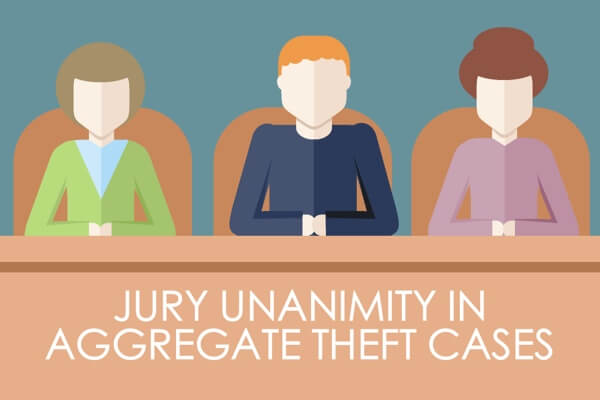
 Jury unanimity is required in every jury trial, whether it be felony or misdemeanor. This means that the jury must unanimously agree that the State has proven or failed to prove all elements of an offense beyond a reasonable doubt. If a jury cannot reach a unanimous verdict of guilty or not guilty, then the judge will declare a mistrial. With some offenses, however, it can be a little unclear as to what jury unanimity actually requires. This is specifically so with aggregated theft cases.
Jury unanimity is required in every jury trial, whether it be felony or misdemeanor. This means that the jury must unanimously agree that the State has proven or failed to prove all elements of an offense beyond a reasonable doubt. If a jury cannot reach a unanimous verdict of guilty or not guilty, then the judge will declare a mistrial. With some offenses, however, it can be a little unclear as to what jury unanimity actually requires. This is specifically so with aggregated theft cases.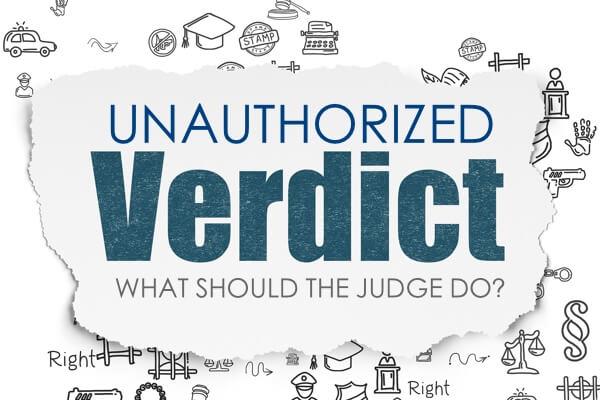
 At the trial of Reginald Nixon for burglary of a habitation and evading arrest, the jury returned a guilty verdict and sentence of 7 years for the burglary and 9 years for the evading. However, the verdict form contained a handwritten note that read: “*To be served consecutively, not concurrently.” A consecutive sentence would mean that the two verdicts are added together to make the actual prison term 16 years. The jury had previously asked the judge whether the sentences would run concurrently and the judge refused to answer them, advising them to simply continue with their deliberations. Without an answer to their question, the jury took the matter into their own hands.
At the trial of Reginald Nixon for burglary of a habitation and evading arrest, the jury returned a guilty verdict and sentence of 7 years for the burglary and 9 years for the evading. However, the verdict form contained a handwritten note that read: “*To be served consecutively, not concurrently.” A consecutive sentence would mean that the two verdicts are added together to make the actual prison term 16 years. The jury had previously asked the judge whether the sentences would run concurrently and the judge refused to answer them, advising them to simply continue with their deliberations. Without an answer to their question, the jury took the matter into their own hands.
 We, like many of you, have been sucked into the sad, frustrating, and very real tale of the murder trial of Steven Avery in Manitowoc County, Wisconsin brought forth in the
We, like many of you, have been sucked into the sad, frustrating, and very real tale of the murder trial of Steven Avery in Manitowoc County, Wisconsin brought forth in the 





